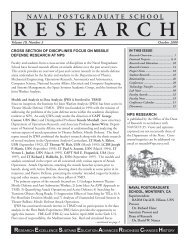Spectral Unmixing Applied to Desert Soils for the - Naval ...
Spectral Unmixing Applied to Desert Soils for the - Naval ...
Spectral Unmixing Applied to Desert Soils for the - Naval ...
Create successful ePaper yourself
Turn your PDF publications into a flip-book with our unique Google optimized e-Paper software.
transitions in which electron movement is between ions or ions and ligands and in Fe, <strong>for</strong><br />
example, are <strong>the</strong> reason <strong>for</strong> its red color. When electrons move amongst two different<br />
energy levels <strong>the</strong>re is a gap in <strong>the</strong> band (band gap) represented by <strong>the</strong> difference in energy<br />
levels. These bands often show <strong>the</strong>mselves in <strong>the</strong> visible range and causes colorations in<br />
some minerals. Color centers are a response <strong>to</strong> impurities and defects in <strong>the</strong> structure of<br />
<strong>the</strong> material and cause <strong>for</strong> example, <strong>the</strong> blue color in fluorite. They show up as<br />
absorption features because <strong>the</strong>y use pho<strong>to</strong>n energy <strong>to</strong> gain electrons (Clark, 1999).<br />
2. Vibrational Processes<br />
Vibrational Processes are associated with <strong>the</strong> crystal lattice structure and <strong>the</strong><br />
bonds within it and can be compared <strong>to</strong> a spring with a weight attached vibrating with<br />
fundamental frequencies and over<strong>to</strong>nes (Clark, 1999; Jensen, 2007). Fundamental<br />
frequencies are <strong>the</strong> normal modes of vibrations; over<strong>to</strong>nes are multiples of <strong>the</strong><br />
fundamental frequency as well as different combinations of it (Clark, 1999; Jensen,<br />
2007). Natural materials exhibiting <strong>the</strong>se vibrational processes include phosphates,<br />
borates, carbonates, water and hydroxyl (Jensen, 2007). Vibration fundamental modes<br />
have traditionally been represented as ν1, ν2, ν3 and over<strong>to</strong>nes as 2 ν1, 3 ν1, 2 ν2 with<br />
combinations being represented as additions and subtractions of fundamentals (Clark,<br />
1999).<br />
3. Imagery Collection, Processing, and Analysis<br />
a. Collection<br />
The collection and analysis of <strong>the</strong>se spectra allows one <strong>to</strong> identify such<br />
things as mineral and rock type in a given area remotely based on its unique absorption<br />
features. The current Hyperspectral Imagery (HSI) technology utilizes spatial resolution<br />
of 2–20 m, spectral resolution of 10–20 nm and a signal-<strong>to</strong>-noise (SNR) ratio that is<br />
greater than 500:1 <strong>for</strong> data collection (Kruse, 2012) On a mineral or rock surface,<br />
incident light (pho<strong>to</strong>ns) can be absorbed, reflected/refracted, or passed through <strong>to</strong> o<strong>the</strong>r<br />
grains of a material. Reflected or refracted light is also called scattered light which can<br />
be directed <strong>to</strong>ward a remote sensing sensor capable of measuring abundances and<br />
properties of some material within <strong>the</strong> sensors field of view (FOV) (Figure 4). When<br />
8
















